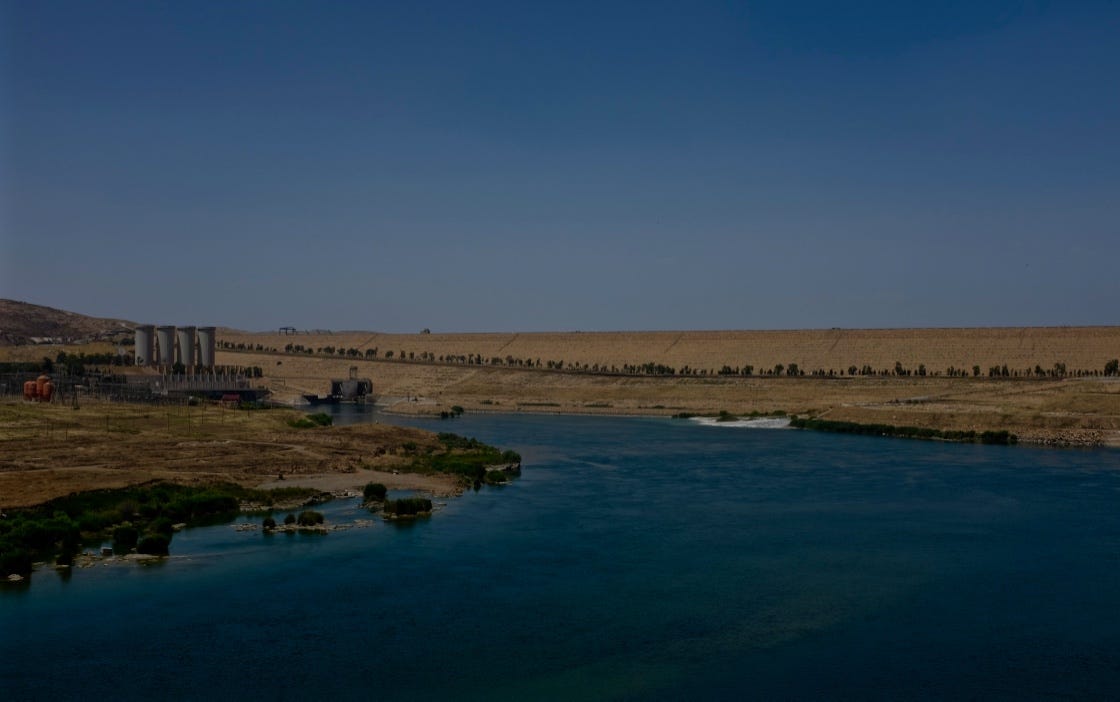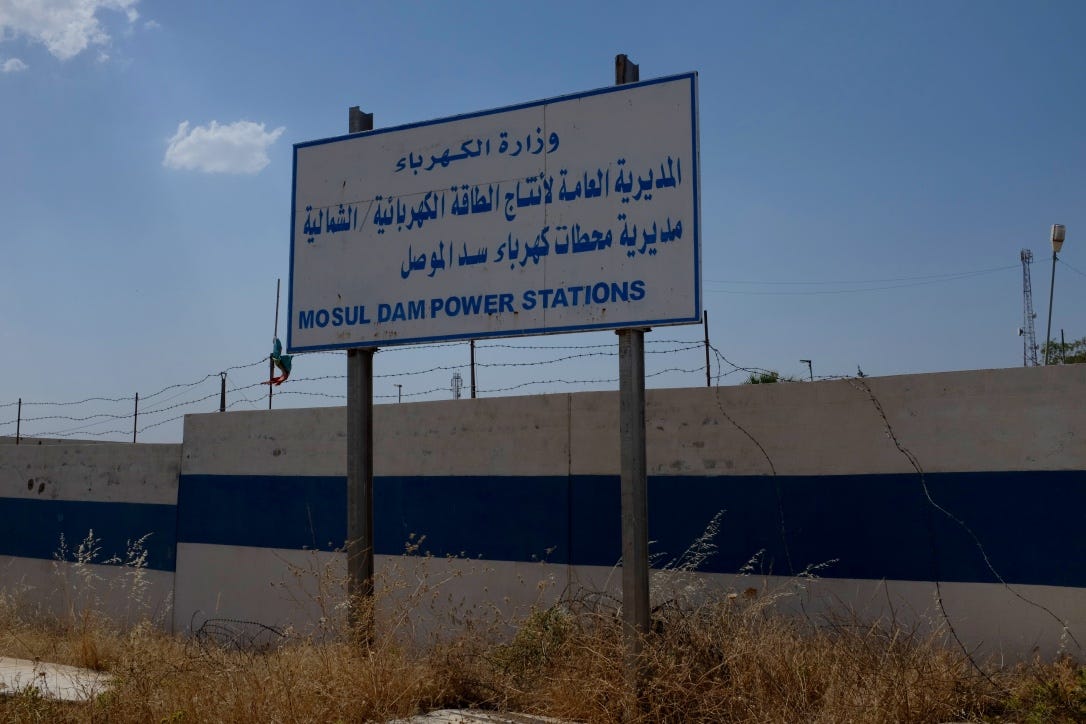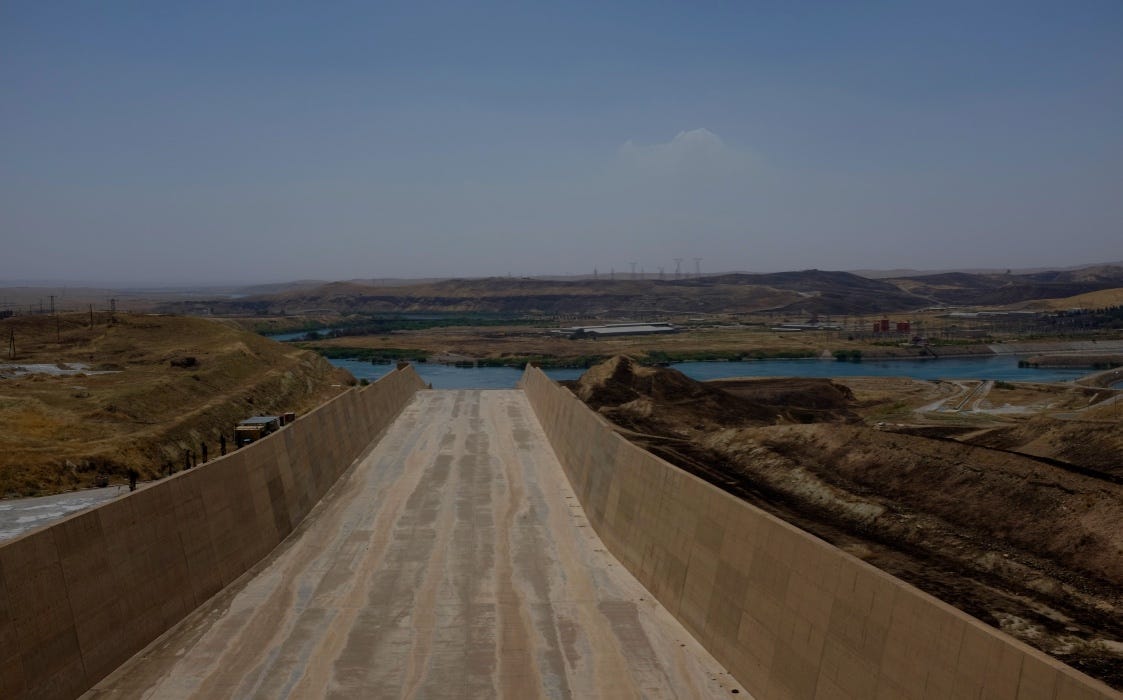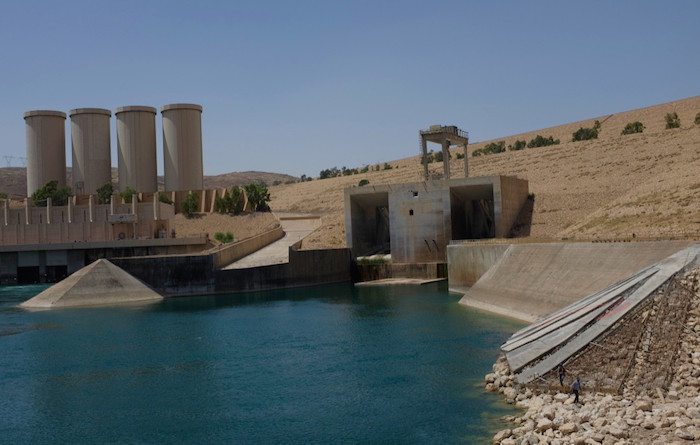U.S. officials have warned a collapse of the Mosul Dam is inevitable without urgent repairs, but work is moving slowly
May 19, 2016 was a good day for Mohsen Hassan, deputy director of the Mosul Dam in Iraq. The sun was shining, the water level in the reservoir had dropped to 310 meters and workers were repairing the dam’s left gate that stopped functioning in 2013.
Even the security situation had stabilized, as the Islamic State — which formerly occupied the dam — had been pushed 21 kilometers away.
Against all odds, there was no sign that the dam was failing. “The dam is in no danger, it will not collapse. No need to worry,” he said while looking out the windows of his corner office in the government building.
A few meters away, the Tigris River poured slowly through the 3.2 kilometer-long dam that keeps 11 cubic kilometers of water contained. The dam is 42 kilometers north of Mosul and functions as a power plant for the surrounding area. It is the biggest dam in Iraq and the fourth largest in the Middle East.
But according to the U.S. Army Corps of Engineers, which began monitoring the Mosul Dam after the 2003 invasion, it is one of the most “dangerous dams in the world” due to its long history of structural problems and the millions of people at risk if the dam collapsed.
Several events have conspired to make that scenario a distinct possibility.
Before the current war with the Islamic State, the Mosul Dam was in trouble.
During the U.S. occupation, the coalition funded a $27 million repair project specifically for the dam. In 2007, the Special Inspector General for Iraq Reconstruction — a U.S. government watchdog set up by Congress — reported that “almost $20 million worth of equipment and materials” for the project never arrived, and that contractors failed safety standards. “The project [was]showing signs of possible fraud,” SIGIR’s conclusion report in 2013 stated.
The German-Italian consortium GIMOD built the Mosul Dam between 1981 and 1986 under a $1.5 billion contract issued by Saddam Hussein. Hassan started working there in 1983.
Hassan insisted that everything was now under control, and that the media had exaggerated the dam’s troubles. He said maintenance work temporarily halted in August 2014 — when the Islamic State controlled the dam for 12 days — but engineers returned to their posts and everything went back to normal after the jihadists were driven out.
He also praised Trevi, the Italian company which won a nearly $300 million contract to help repair the dam. No company but Trevi participated in the bidding process. The U.S. Army Corps of Engineers was recently awarded another contract to oversee the dam’s work, overseeing what Trevi is doing, while being the organization which pushed Trevi to get the contract in the first place.
“I don’t know the contract details, I have not seen it; though Trevi will do the same things that we are already doing,” Hassan said. The Italians “will bring new machinery, new equipment. They are really good, best ones in the field.”
The firm’s main responsibility will be grouting. That is, pumping cement into the foundation of the dam to prevent the formation of cavities, which couldcompromise its stability. No cavities, no problem. The only problem is that it might not be enough to save the Mosul Dam.

About 3,500 miles away, Nadhir Al Ansari, a soil mechanics expert and professor at the Luleå University of Technology in Sweden, busily prepared an official proposal for the Iraqi government. He recently organized a workshop with a dozen of the best civil engineers in the world to discuss the Mosul Dam situation and find a possible solution.
Since January, Al Ansari has been outspoken about the dam’s risk to populated areas and is critical of the work to shore up the dam’s structure — in short, there is not enough of it. “Trevi’s intervention is not long term, the dam is in serious danger and at stake there are millions of people’s lives,” Al Ansari said.
According to the most recent study by the European Union, a catastrophic failure of the Mosul Dam could affect at least six million people. Up to 1.5 million could die. Iraq’s major cities would be underwater within hours. Mosul could be hit with 10-meter-high waves. Even Baghdad, over 300 kilometers away, would be flooded.
Al Ansari blamed the Iraqi government for downsizing the alarm, forcing engineers to lie about the real state of the dam, and he criticized the Italians for not responding to the emergency in a timely manner. “They will start to work in September when the water is low and the intervention will cost less,” he added.
U.S. officials are growing anxious. Early in 2016, Pres. Barack Obama received a memo that described a potential dam failure as a bigger threat than the Islamic State. To make matters worse, the dam’s condition has deteriorated, largely because of the shortage in trained engineers.
The most recent troubles started on Aug. 7, 2014, when the Islamic State routed Kurdish and Iraqi forces and took control of the dam. Most of the 360 engineers there, and up to 3,000 people including workers and their families, fled for their lives. The grouting work halted.
One complication — the dam needs constant grouting, and has since it first began operating in 1986. Even a halt to operations for a mere 10 days can compromise the foundation and open cavities from the downstream side of the dam into the reservoir and its enormous reserves of water.
Cavities are very bad news in the world of dam engineering. The Mosul Dam is also particularly vulnerable to this phenomenon due to the high concentration of soluble gypsum in the foundation’s soil. As water seeps through the gypsum, the soil dissolves and cavities form … which can eventually lead to a total collapse.
Less than a week after the Islamic State assault and with the situation becoming critical, the peshmerga — the military force of the nearby autonomous Kurdistan Region — took over the job of recapturing the dam. With the Iraqi army nowhere to be seen, the Kurds launched an offensive which lasted two days.
“It was a very forceful battle,” said Farhad Mohammed, a Kurdish military police officer who has been stationed on the dam since that day.
The Islamic State mined the bridge, launched rockets and blocked roads, but according to Mohammed everyone — including the jihadists — was careful not to hit the actual structure. As soon as the peshmerga were in control of the area, as many as 60 engineers came back and the grouting started again.
But the grouting is still intermittent — when it needs to be constant—as the engineering team is undermanned. To further complicate the situation, the factory near Mosul which produced the cement to be injected into the dam is still in the Islamic State’s hands, and has since stopped production. Luckily, the engineers found a new supplier, but its grout is of a different consistency.
The U.S. Army’s engineers have also become involved. Soon after the peshmerga kicked out the Islamic State, the Corps arrived and placed more than 1,200 sensors on the dam, 90 of which are connected to the Internet, allowing the engineers to download the data at any time. Following a year of monitoring, the Corps concluded that the dam remains in great distress.
“All the information gathered in the last year indicates Mosul Dam is at significantly higher risk of failure than originally understood and is at a higher risk of failure today than it was a year ago,” the Corps warned in a report “for official use only” released in the fall of 2015.
As the document circulated, governments seemed eager to find a solution. The Corps recommended the maintenance work be appointed to the Italian firm Trevi.

Based in Cesena, Italy, the company was founded in 1957 and is a family-owned business listed on the stock exchange. In 2014, the firm made 1.2 billion euros in revenue. The Italian group has an American branch called Treviicos since the acquisition of ICOS Boston in 1997.
From 2001 onward, the company won several bids for dam maintenance around the United States, the last one in 2014 for the Bolivar Dam near Canton, Ohio. It also worked in the World Trade Center reconstruction and in the aftermath of Hurricane Katrina. The group has worked closely with the Corps for more than 15 years.
On Dec. 16, 2015, Italian Prime Minister Matteo Renzi announced that Rome would send an additional 450 soldiers, on top of the 700 already in Iraq, to protect the dam. He also noted that Trevi won the repair contract, though no formal announcement was made by the Iraqi government at that time.
The mission is “important, very close to the Islamic State,” Renzi said.
Soon after Renzi’s speech, Trevi disappeared from public statements on the dam project. On Feb. 2, Iraq’s Ministry of Water Resources sent a formal document to the Iraqi parliament — quoting the Corps report— which stated that Trevi was the only company to respond to the bid, so the parliament should formally request money from the World Bank to hire the firm.
As the process trudged onward, U.S. officials went on high alert. News about the dam’s potential failure started leaking to the press. In January 2016, Lt. Gen. Sean MacFarland, commander of the U.S.-led coalition against the Islamic State in Iraq and Syria, said that Iraq should have drained the lake.
A few days later, the U.S. embassy in Baghdad issued a warning about the Mosul Dam’s “unprecedented risk of catastrophic failure with little warning.” Next, Samantha Powers, the U.S. ambassador to the United Nations, weighed in with a series of tweets, in which she highlighted the potential for disaster.
It was all a means to push the Iraqi government to plan for safeguarding the population in case something went wrong. “It would be irresponsible not to prepare the public in case such a disaster were to occur,” a State Department official said.
In March, the U.S. State Department hired the firm MosCamp to supply portable mini-dams to protect the embassy and Baghdad International Airport. “An exhaustive analysis of the physical condition of the dam has been done,” the department explained. “It has been determined that without repairs, it is a case of when not if failure will occur.”
Baghdad has begun coordinating with U.N. agencies to inform people on the ground what to do in the event of the collapse, including telling people that if they hear sirens, they should leave the area. The alert spread over the news in Iraq, and it also reached Mosul, the second largest city in Iraq and which is currently under Islamic State control.
According to sources on the ground, the following Friday sermon issued by an Islamic State cleric accused the coalition of attempting to frighten people in Mosul so they would leave, allowing Iraqi troops to retake the city with less effort. However, a few weeks later, the Islamic State evacuated Al’arabi and Alhadbaa, two neighborhoods on the east bank of the city which are the closest to the Tigris River.

As public pressure grew, the Iraqi government sped up the repair process. On March 2, Trevi signed the dam contract. But by the end of March, the sense of urgency disappeared, and statements from the group halted. Mentions of the dam’s progressive rate of failure ceased.
“Of course the situation is critical, though if it was so desperate we would have started straight away,” said a company official who requested anonymity.
Italian Ministry of Defense officials also have a relaxed attitude, insisting there is a higher risk that the Islamic State might push back into the area. The Mosul Dam is now protected by the zeravani, an elite unit among the peshmerga, who will stay and work closely with the Italian military.
Trevi signed an 18-month contract, with the first six months dedicated to constructing a barracks to house Italian troops and civilian engineers. In May, some technicians and engineers visited the dam, but none stayed, according to Hassan.
The work will start in September, bypassing the most critical moment which went from March to June, marked by the rainy season and the snow melting. The contract will be extended, several sources confirmed. For the Corps’ part, it will oversee the work and provide technical experts.
It remains unclear who is paying the Corps for this project, as Baghdad is on the edge of bankruptcy. While several sources confirmed the contract is paid for by the World Bank, the institution denied any “direct” funding.
“The government of Iraq wants to create a committee that overlooks both Trevi and [the Corps’]work,” said Nasrat Adamo, the Mosul Dam’s former chief engineer who now lives in Sweden. The committee will include a panel of experts and be funded by the World Bank.
Adamo helped organize the recent civil-engineering workshop in Sweden. “The workshop was strictly technical with no political or promotional goals except trying to understand the technical nature of the problem and helping in solving it,” he said.
A short-term fix is more realistic — a longer-term one is harder to stomach. From 1986 to 2014, 950,000 tons of cement was pumped into the dam’s foundation, leaving many doubts about the long-term viability of the structure. “A Swiss company recommended that site,” Al Ansari said. “I don’t understand why at the time Saddam didn’t sue the company. He should have had.”
Al Ansari knows that $300 million will not do anything more than patch up the foundation. This is why he is so keen on finding alternative solutions. “We thought that finishing the construction of the Badush Dam [between Mosul city and Mosul Dam]could be an alternative,” he said.
“Otherwise, constructing a diaphragm to relieve the pressure on the dam, but that will cost at as much as $1.9 billion.”
Ironically, Trevi was also part of the consortium that originally built the Mosul Dam in the 1980s. Although the sense of urgency disappeared from public discourse, Al Ansari knows another crisis is just around the corner.


